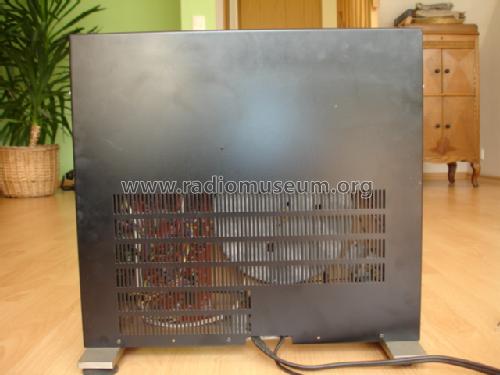- Country
- Japan
- Manufacturer / Brand
- Mitsubishi Electric Corporation
- Year
- 1979
- Category
- Sound/Video Recorder and/or Player
- Radiomuseum.org ID
- 149706
Click on the schematic thumbnail to request the schematic as a free document.
- Wave bands
- - without
- Details
- Record Player (not changer)
- Power type and voltage
- Alternating Current supply (AC) / 220 Volt
- Loudspeaker
- - For headphones or amp.
- Material
- Various materials
- from Radiomuseum.org
- Model: LT-5V - Mitsubishi Electric
- Shape
- Miscellaneous shapes - described under notes.
- Dimensions (WHD)
- 466 x 430 x 200 mm / 18.3 x 16.9 x 7.9 inch
- Notes
- Senkrecht-Laufwerk mit Riemenantrieb.
Radialer Haltebügel mit Schellverschluss: Hält die Platte sicher auf der Mittelachse.
Tonabnehmersystem AT-12E von Audio Technica.
- Net weight (2.2 lb = 1 kg)
- 12.5 kg / 27 lb 8.5 oz (27.533 lb)
- Source of data
- -- Original prospect or advert
- Mentioned in
- Funkschau (21/1979, S. 1215 / Internationale Funkausstellung)
- Author
- Model page created by Franz Scharner. See "Data change" for further contributors.
- Other Models
-
Here you find 325 models, 266 with images and 92 with schematics for wireless sets etc. In French: TSF for Télégraphie sans fil.
All listed radios etc. from Mitsubishi Electric Corporation
Collections
The model is part of the collections of the following members.
Forum contributions about this model: Mitsubishi Electric: LT-5V
Threads: 1 | Posts: 1
Wenn der Tonarm beim Abspielen einer Platte hängen bleibt, kann es an der der Gabellichtschranke im Kopf des Tonarms liegen. Dort sind zwei kleine Glühlampen für die Lichtschranke eingebaut.
Der Tonarm setzt auf, die Platte wird abgespielt, aber der Tonarmmotor bewegt den Tonarm nicht weiter.
Irgendwann kommt der Tonarm an seinen Anschlag und die Nadel springt.
Dort sind 3mm Subminiaturlampen verbaut: OSHINO 12V-0,03A-0,36W T1-Subminiaturlampe mit Drahtenden. Die gibt es z.B. bei ASWO.
Die gleichen Lampen sind in den Lichtschranken für die Einlaufrille für 17cm und 33cm Platten und für die Erkennung der Auslaufrille.
Thomas Teipel, 09.Oct.23


































